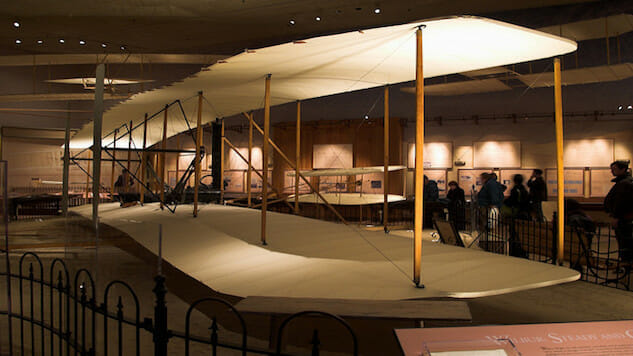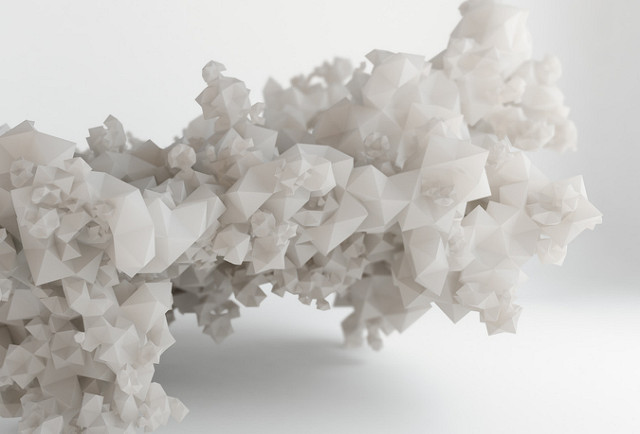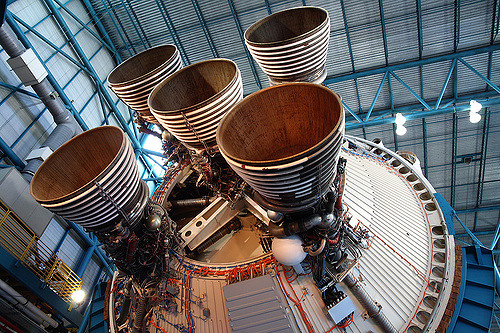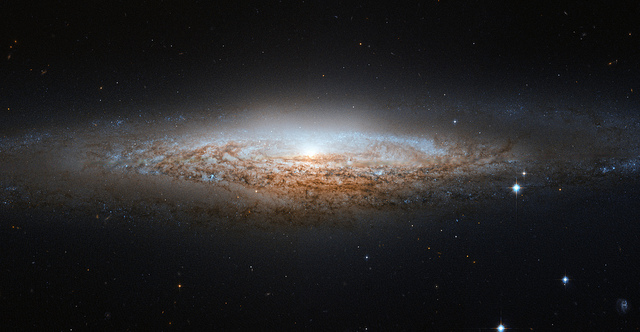
Vaccinating polio, putting a man on the moon, the Segway … few countries can match the scientific influence of the United States. Because of this, we decided to pit state against state to see which single scientific contribution—California can’t claim the Internet and the expansion of the universe, for example—is the greatest of them all.
![]()
50. New Hampshire: Does the Segway count?
 Photo: Steven Lilley
Photo: Steven Lilley
Eh, it’ll have to do.
49. Indiana: Thanks, Indiana, for the breathalyzer
For a state where selling alcohol on Sunday is illegal, this is surprising.
48. West Virginia: The only house in the world made of coal
Its contribution to science? They’re not burning said coal.
47. South Dakota: Raptors, big-ass raptors
If you thought South Dakota’s only contribution to the science world was whatever breed of human that participates at the supposedly world famous “Mashed Potato Wrestling Contest,” you’d be wrong! The state also had insanely large raptors some 66 million years ago. So there’s that, too.
46. Idaho: A farmer found an assortment of late Pliocene fossils
The most exciting part of this contribution is that the farmer’s name was Elmer Cook.
45. Colorado: The abominable Snowmastodon.
 Photo: Lara Eakins
Photo: Lara Eakins
Imagine finding a Land Before Time-esque graveyard at work one day. That’s what happened to some construction workers near Snowmass Village, Colorado. The team unearthed a haul of 4,826 bones from 26 different Ice Age vertebrates, the most notable of which was a 50,000-year-old mastodon.
44. Nebraska: CliffNotes
Saving procrastinating students since 1958.
43. Oklahoma: The Ditch Witch
Though its name sounds like the villain in a German fairytale, the Ditch Witch had farmers rejoicing because it meant the end of hand tools when preparing the ground for crops.
42. North Dakota: Gave the world “The Chicken from Hell.”
Since we can’t consider Cream of Wheat a “scientific contribution,” we settled with the Chicken from Hell because nothing is more simultaneously terrifying and appetizing as an 11-foot, 500-pound chicken.
41. Wyoming: The “Dental Gauge”
A.k.a. Headgear.
40. Utah: Atari
Atari is a video game. Developing a video game requires some background knowledge in computer science; thus, by the transitive property, this counts as some sort of scientific achievement.
39. Kansas: Helium loves the Great Plains
Drilling for natural gas in 1903, drillers stumbled upon a bizarre discovery: helium. Dexter gas as it was called contained 15 percent methane, 72% nitrogen and nearly 2 percent helium, which indicated that, despite the element’s overall rarity on Earth, helium was concentrated under the Great Plains.
38. Oregon: A 14,000-year-old colony
 Photo: Bureu of Land Management Oregon
Photo: Bureu of Land Management Oregon
The first known North American colony seems have existed in Oregon’s Paisley Caves. Researchers have found stone projectile points, fossilized excrement, and, of course, bones. Perhaps more relevant, this discovery also probably means that these cave dwellers are the original hipsters, having lived in Portland 14,000 years before it was cool.
37. Vermont: Photographing snowflakes
Wilson Bentley is probably the reason mothers call their children “special snowflakes.” The Vermont farmer captured the first images of single snowflakes on camera. In his collection of thousands of prints, no two are alike.
36. Arizona: Found Pluto
… which was probably more exciting thirty years ago. Discovered by Clyde Tombaugh at Flagstaff’s Lowell Observatory in 1930, the new-found quickly become the ninth in our solar system. Of course, since then, Pluto’s been demoted to “dwarf” status—the minor leagues of solar system planets.
35. Arkansas: Synced sound and picture when filming
 Photo: dailyinvention
Photo: dailyinvention
This ultimately lead to the advancement of “talkies,” which, of course, lead to The Godfather and Casablanca. But it also lead to Adam Sandler and The Black Gestapo.
34. Ohio: The world of synthetic rubber
If you’ve ever wondered why Akron, Ohio, smells like rubber (not a joke), it’s because Charles Goodyear manufactured the first synthetic rubber, later used for tires, in this Rust Belt town.
33. Kentucky: Moonshine? Nah, the tri-colored traffic light
Tommy Guns, Moonshine, and the traffic light—that’s Kentucky innovation. Paris, Kentucky native Garrett Morgan invented the first tri-colored traffic light in 1923, and it’s that rendition that can be seen all over American roads today.
32. Maryland: Discovered the jacket to our DNA
Telomeres, as they’re called, are like the wax tips on our shoelaces. Without these tips, the laces fray. Telomeres provide the same protection to our chromosomes, without which DNA would spatter.
31. Louisiana: The first practical binocular microscope
Almost every researchable disease, doctoral analysis, or even middle school cork cell experiment can trace its roots to John Riddell’s creation of the binocular microscope. That said, other, non-binocular microscopes work just fine.
30. Minnesota: Keeps hearts beating with the battery-powered pacemaker
Prior to the Earl Bakken’s tweaking, pacemakers were massive machines carted next to patients. There was no way you could fly, go for a run, or, really, lead an active life, in general.
29. Florida: Let there be artificial air
 Photo: Jan Tik
Photo: Jan Tik
Air conditioning may not be the most noteworthy scientific achievement coming out of Florida, a state that helped create the cancer medication Taxol, the home to NASA’s Kennedy Space Center, and birthplace of Sunny Delight, but it’s impossible not to acknowledge the importance of air conditioning in a place like Florida—or anywhere south of the Mason Dixon Line. Ain’t nobody want to spend a day literally stuck to their leather sofa.
28. Delaware: DuPont invented nylon—and possibly Jeff Gordon—but mostly nylon
DuPont’s given the world wonderful new polymers like neoprene, tyvek, kevlar, corian, and Jeff Gordon. But none have made an impact quite like nylon, which is used in everything from clothing to packaging to toothbrushes to sausage casings. Odds are high that, at this moment, you’re using some form of the synthetic material.
27. Wisconsin: Started the stem cells debate
Should stem cells be used for research? The question began when, in 1998, at the University of Wisconsin, James Thomson isolated and grew stem cells from human embryos for the first time. Though scientifically miraculous and full of research possibilities, the procedure set off one of the biggest ethical debates in the history of science. Thankfully, nine years later in 2007, the lab lulled naysayers when it extracted stem cells from normal human cells.
26. Missouri: Microchips
Next time you see a smartphone, tablet, computer, or some cheesy CBS drama, thank Missouri’s own Jack Kirby for microchip technology.
25. South Carolina: The submarine
 Photo: Mariano Mantel
Photo: Mariano Mantel
H.L. Hunley may not have been a Sandlapper, but his invention, the submarine, certainly is. Developed and launched in 1863, the first submarine was used as a Confederate weapon during the Civil War. Today, Hunley should be happy to know his invention further technologized warfare, opened the doors for marine biology, and kickstarted Naval stereotypes.
24. Mississippi: The world’s first lung transplant
The state known for creating the “Soft Toilet Seat” and fungal creams also performed the world’s first human lung transplant, which was performed by Dr. James Hardy at the University of Mississippi in 1963.
23. New Jersey: Taught us the Earth is made of ever-shifting plates
W. Jason Morgan, a geoscience professor at Princeton, noticed something “off” about the Earth’s crust. At the time (mid 1960s), scientists assumed the crust deformed during instances of earthquakes. Morgan saw something else. He proposed the crust consisted of a dozen rigid plates, which moved relative to each other, and this proposal in plate tectonic theory has since revolutionized our understanding of the geological forces that control the earth’s crust.
22. Maine: Transatlantic television signals
A collaboration between U.S., French, and British broadcasting agencies, Telstar was launched as the first active communication satellite, enabling TV programs to be broadcast across the Atlantic. The three-foot tall satellite brought the BBC to America and, in return, America gave Europe The Beverly Hillbillies.
21. Nevada: Solar cells and, with that, the foundation of solar power
By the turn of the 19th century, the U.S. could have had a functional solar grid if it had followed the lead of Charles Fritts, creator of the first working Selenium Cell. Solar power today could look quite different—more notably, exist.
20. Alaska: Leads the way in climate-change research
Most Alaskan contributions have a decidedly northern focus. For example, few people outside of the Arctic are interested in helmet lights for snowmobilers or tubes that make it easier to bury the dead in permafrost. But scientists in Alaska are using this northern focus on tracking global climate patterns like the melting of polar caps and the subsequent changes in sea level.
19. Iowa: Quasicrystals are cool, right?
 Photo: Aranda/Lasch
Photo: Aranda/Lasch
The secret of a quasicrystal is that its patterns never repeat. Why’s that important in the world of chemistry? It revealed a completely new principle for the packing of atoms and molecules—patterns, order didn’t matter. Shechtman’s discovery created one of the biggest paradigm shifts in the field, and, still today, more than thirty years later, physicists struggle to understand why quasicrystals have these properties.
18. Virginia: The pursuit of science as an American ideal
Virginia has given us the grain harvester, connected the lymphatic system to the brain, and the swivel chair. Moreover, though, Virginia gave America Thomas Jefferson, founding father of science. Though his inventions—like the folding chair—are unremarkable, Jefferson popularized science as an American ideal, “Science has liberated the ideas of those who read and reflect, and the American example has kindled feelings of right in the people.”
17. Rhode Island: The Zeroth Law of Thermodynamics
Brown University research instructor Lars Onsager’s contribution to thermodynamics was so important that they named the fourth law of thermodynamics as the Zeroth Law, which states, “If two thermodynamic systems are each in thermal equilibrium with a third, then they are in thermal equilibrium with each other,” basically meaning if A=B and C=B then A=C. Simple enough, right? Not so. Without this law, temperature couldn’t be defined. Thermometers couldn’t be built. You’d probably never know when to wear a sweater.
16. Hawaii: Dark Matter
Dark energy, black holes, exoplanets – Hawaii’s Keck Observatory is largely responsible for the continued advancement of astronomy and probably the progression of Sci Fi.
15. Massachusetts: Made the first phone call
“Mr. Watson, come here. I need you,” were the first words Alexander Graham Bell spoke to his assistant the day he made the first ever phone call in Boston in 1876.
14. Michigan: The moving assembly line
 Photo: Ford Europe
Photo: Ford Europe
Developed for the Ford Model T, the assembly line, driven by conveyor belts, saw the production time for a Model T reduced to a mere 93 minutes—faster than the paint could dry. At its peak, the line produced 10,000 Model T cylinder blocks per day.
13. Illinois: The University of Chicago set off the first nuclear reaction
The University of Chicago alone probably deserves a top-ten list of scientific contributions but none seem more important than the creation of the first nuclear chain reaction in 1942. Thus began the atomic age—which has yet to end.
12. North Carolina: First in flight
Twelve seconds in Kitty Hawk changed the world. After four years in development—and innumerable crashes—Orville and Wilbur Wright took their flying machine to test on the hills of Kitty Hawk. Their first flight lasted twelve seconds, but, by day’s end, the plane managed a trip of 852 feet with nearly a minute of air time.
11. Washington: Windows 95 redefined home computing
1995: “Gangsta’s Paradise” topped the charts; Seinfeld the TV screens; and Nic Cage was an Oscar winner. It was also in 1995 that Microsoft redefined home computing with the launch of Windows 95, a move that saw the Start Menu, software that worked with almost all hardware on the market, and Internet Explorer—the first web browser for many. Computers transformed into something beyond spreadsheets.
10. Georgia: Surgeons began using ether as an anesthetic
Prior to ether, surgeons thought everything from cocaine to the old chloroform trick were the best forms of anesthesia. That’s when Crawford Long, after noticing his friends felt no pain while under the influence of ether, administered the drug to patients going under the knife.
9. Montana: Made a bunch of vaccines
Miles City microbiologist Maurice Hilleman is credited with saving more lives than any other medical scientist of the 20th century. Why? His forty vaccines includes those for measles, mumps, hepatitis A and B, chickenpox, meningitis, pneumonia, and influenza.
8. Connecticut: Pretty much the entire works of Josiah Willard Gibbs
“The greatest mind in American history,” according to Einstein. Josiah Willard Gibbs, a mathematical physicist at Yale, discovered “chemical potential” and introduced the concept of “free energy,” the foundation of thermodynamics and vector analysis. This discovery also lead to the thousands of students who, like this author, drop out of introductory Physics programs.
7. Alabama: Launched America to the moon
 Photo: Carlos Ayala
Photo: Carlos Ayala
Alabama has made a surprising amount of scientific contributions—vinyl, airbags, the Super Soaker—for a state that’s largely brought us “people of Walmart,” but none seem more important, particularly in the context of “America,” than the Saturn V rocket. The rocket and lunar roving vehicle, used during the final three Apollo missions, are the mother and father of American space travel and both can call Alabama home.
6. Texas: Put America on the moon
The rockets may have been made in Alabama but the mission was led in Texas. NASA’s Johnson Center is “Mission Control.” It’s “Houston, we have a problem.” And, more importantly, it’s “Houston, Tranquility Base here. The Eagle has landed.”
5. New York: Formed the basis for genetics
Before 1933, genetics as a scientific discipline didn’t exist. It wasn’t until Thomas Hunt Morgan and his colleagues, after painstakingly examining the chromosomes tens-of-thousands of fruit flies, confirmed that some genes are linked—meaning those genes located on the same chromosome are inherited together.
4. Pennsylvania: Vaccinated Polio
In 1952, 22,000 Americans had Polio. Today, that number’s down to 96, thanks to Jonas Salk who developed the vaccine at the University of Pittsburgh in 1955. The vaccine has been so effective that the World Health Organization thinks the disease can be eradicated by April 2017.
3. New Mexico: Brought us the nuclear age
On July 16, 1945, the U.S. dropped the first atomic bomb in Los Alamos, New Mexico. Whether good or bad, the impact of that drop has gone on to influence not only the science community but, more importantly, global politics.
2. Tennessee: The garbage truck and garbage collection
If a Congress stays home for a week, it’s business as usual. If garbagemen stay home for a week, it’s a state of emergency. At least that’s what happened three days into a NYC trash collector’s strike. The sanitation system isn’t a pretty innovation, but it’s perhaps the most necessary function in nearly every city.
1. California: Edwin Hubble observed that the universe expanding
 Photo: NASA Goddard Space Flight Center
Photo: NASA Goddard Space Flight Center
If any discovery has changed how we view the world, it’s Hubble’s analysis that the Milky Way is just one of many, many galaxies. In 1929, the astronomer expounded on that observation, noting that the universe is expanding, based on observations of starlight from distant galaxies. This theory lead to the conception of The Big Bang.
Top photo: TimothyJ CC-BY-2.0
Tom is a travel writer, part-time hitchhiker, and he’s currently trying to imitate Where in the World is Carmen Sandiego? but with more sunscreen and jorts.